XPRIZE Rainforest
- Since 2022 I have been developing computer vision tools for Limelight: Rainforest, the first place winners of the XPRIZE rainforest competition. XPRIZE Rainforest was a 10 million dollar competition to develop automated technology capable of rapidly surveying biodiversity in tropical forests, concluded in November of 2024.

In June of 2023 Limelight: Rainforest competed in the XPRIZE Rainforest semifinals competition in Singapore. In a 24 hour period we were able to photograph more than 17,000 insects from 47 different families. With the addition of acoustic monitoring, DNA barcoding, and eDNA, we were able to identify 21 named species, 46 unique genera, 62 unique families, and 21 orders of plants and animals from the sampling area. Limelight: Rainforest was one of 6 finalist teams selected from the 13 competitors.